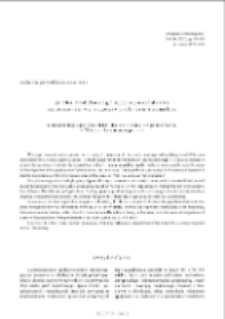- Search in all Repository
- Literature and maps
- Archeology
- Mills database
- Natural sciences
Advanced search
Advanced search
Advanced search
Advanced search
Advanced search

Object
Title: Próba modelowego ujęcia gospodarki na Pomorzu we wczesnym okresie rzymskim
Subtitle:
A modeling approach to the economy of Pomerania in the Early Roman Period ; Przegląd Archeologiczny T. 60 (2012)
Publisher:
Instytut Archeologii i Etnologii Polskiej Akademii Nauk ; Ośrodek Badań nad Kulturą Późnego Antyku i Wczesnego Średniowiecza
Place of publishing:
Description:
S. 83-105 : il. ; 29 cm ; Bibliogr. s. 102-104 ; Streszcz. w jęz. ang.
Type of object:
Abstract:
This paper is an attempt to present the economy in Pomerania in the Early Roman Period applying a model that was used before by J. Ostoja-Zagórski and M. Henneberg for fortified settlements of the Biskupin type. It is also an attempt to answer the question of whether the exploitation of the environment and the need to find new areas to settle were the cause of the migration of the population of Pomerania to the south-east. The hypothesis constructed in the course of research is that the exploitation of the environment was not the cause of "the relocations of the population".First, the average size of a single group of people living in Pomerania in the Early Roman Period was established, as well as and the amount of time that such a group could spend on working in a year, depending on whether the day work lasted 6, 8 or 10 hours. The efficiency of agriculture, farming, gathering and hunting, as well as of non-agricultural activities has been checked. The approximate duration of activities related to these branches of economy has been also determined.In summary, the time required to complete each activity has been compared to the time the population had at its disposal throughout the year. The results of the analysis have enabled to prove the hypothesis formulated at the beginning, that non-economic factors, rather than the economical difficulties in living in that area, were the cause of migrations of a part of the population from Pomerania to the south-east in the B2/C1 phase
Relation:
Volume:
Start page:
End page:
Detailed Resource Type:
Format:
Resource Identifier:
oai:rcin.org.pl:50556 ; 0079-7138
Source:
IAiE PAN, sygn. P III 149 ; IAiE PAN, sygn. P III 272 ; IAiE PAN, sygn. P III 353 ; click here to follow the link
Language:
Rights:
Prawa zastrzeżone - dostęp nieograniczony
Terms of use:
Digitizing institution:
Instytut Archeologii i Etnologii Polskiej Akademii Nauk
Original in:
Library of the Institute of Archaeology and Ethnology of the Polish Academy of Sciences
Projects co-financed by:
Ministra Nauki i Szkolnictwa Wyższego
Access:
Object collections:
- Digital Repository of Scientific Institutes > Partners' collections > Institute of Archeology and Ethnology PAS > Institute Publications
- Digital Repository of Scientific Institutes > Partners' collections > Institute of Archeology and Ethnology PAS > Institute Publications > Current Journals
- Digital Repository of Scientific Institutes > Literature > Journals/Articles
- Digital Repository of Scientific Institutes > Partners' collections > Institute of Archeology and Ethnology PAS > Institute Publications > Current Journals > Przegląd Archeologiczny
Last modified:
Feb 2, 2022
In our library since:
Dec 17, 2014
Number of object content downloads / hits:
302
All available object's versions:
https://rcin.org.pl./publication/68857
Show description in RDF format:
Show description in RDFa format:
Show description in OAI-PMH format:
| Edition name | Date |
|---|---|
| Gryzińska-Sawicka, Natalia, 2012, Próba modelowego ujęcia gospodarki na Pomorzu we wczesnym okresie rzymskim | Feb 2, 2022 |
Objects Similar
Naukowy Zjazd Pomorzoznawczy (4; 1934; Kraków)
Dymaczewski, Aleksander (1930–1984)
Wielopolski, Alfred (1905–1996)

 INSTYTUT ARCHEOLOGII I ETNOLOGII POLSKIEJ AKADEMII NAUK
INSTYTUT ARCHEOLOGII I ETNOLOGII POLSKIEJ AKADEMII NAUK
 INSTYTUT BADAŃ LITERACKICH POLSKIEJ AKADEMII NAUK
INSTYTUT BADAŃ LITERACKICH POLSKIEJ AKADEMII NAUK
 INSTYTUT BADAWCZY LEŚNICTWA
INSTYTUT BADAWCZY LEŚNICTWA
 INSTYTUT BIOLOGII DOŚWIADCZALNEJ IM. MARCELEGO NENCKIEGO POLSKIEJ AKADEMII NAUK
INSTYTUT BIOLOGII DOŚWIADCZALNEJ IM. MARCELEGO NENCKIEGO POLSKIEJ AKADEMII NAUK
 INSTYTUT BIOLOGII SSAKÓW POLSKIEJ AKADEMII NAUK
INSTYTUT BIOLOGII SSAKÓW POLSKIEJ AKADEMII NAUK
 INSTYTUT CHEMII FIZYCZNEJ PAN
INSTYTUT CHEMII FIZYCZNEJ PAN
 INSTYTUT CHEMII ORGANICZNEJ PAN
INSTYTUT CHEMII ORGANICZNEJ PAN
 INSTYTUT FILOZOFII I SOCJOLOGII PAN
INSTYTUT FILOZOFII I SOCJOLOGII PAN
 INSTYTUT GEOGRAFII I PRZESTRZENNEGO ZAGOSPODAROWANIA PAN
INSTYTUT GEOGRAFII I PRZESTRZENNEGO ZAGOSPODAROWANIA PAN
 INSTYTUT HISTORII im. TADEUSZA MANTEUFFLA POLSKIEJ AKADEMII NAUK
INSTYTUT HISTORII im. TADEUSZA MANTEUFFLA POLSKIEJ AKADEMII NAUK
 INSTYTUT JĘZYKA POLSKIEGO POLSKIEJ AKADEMII NAUK
INSTYTUT JĘZYKA POLSKIEGO POLSKIEJ AKADEMII NAUK
 INSTYTUT MATEMATYCZNY PAN
INSTYTUT MATEMATYCZNY PAN
 INSTYTUT MEDYCYNY DOŚWIADCZALNEJ I KLINICZNEJ IM.MIROSŁAWA MOSSAKOWSKIEGO POLSKIEJ AKADEMII NAUK
INSTYTUT MEDYCYNY DOŚWIADCZALNEJ I KLINICZNEJ IM.MIROSŁAWA MOSSAKOWSKIEGO POLSKIEJ AKADEMII NAUK
 INSTYTUT PODSTAWOWYCH PROBLEMÓW TECHNIKI PAN
INSTYTUT PODSTAWOWYCH PROBLEMÓW TECHNIKI PAN
 INSTYTUT SLAWISTYKI PAN
INSTYTUT SLAWISTYKI PAN
 SIEĆ BADAWCZA ŁUKASIEWICZ - INSTYTUT TECHNOLOGII MATERIAŁÓW ELEKTRONICZNYCH
SIEĆ BADAWCZA ŁUKASIEWICZ - INSTYTUT TECHNOLOGII MATERIAŁÓW ELEKTRONICZNYCH
 MUZEUM I INSTYTUT ZOOLOGII POLSKIEJ AKADEMII NAUK
MUZEUM I INSTYTUT ZOOLOGII POLSKIEJ AKADEMII NAUK
 INSTYTUT BADAŃ SYSTEMOWYCH PAN
INSTYTUT BADAŃ SYSTEMOWYCH PAN
 INSTYTUT BOTANIKI IM. WŁADYSŁAWA SZAFERA POLSKIEJ AKADEMII NAUK
INSTYTUT BOTANIKI IM. WŁADYSŁAWA SZAFERA POLSKIEJ AKADEMII NAUK


































